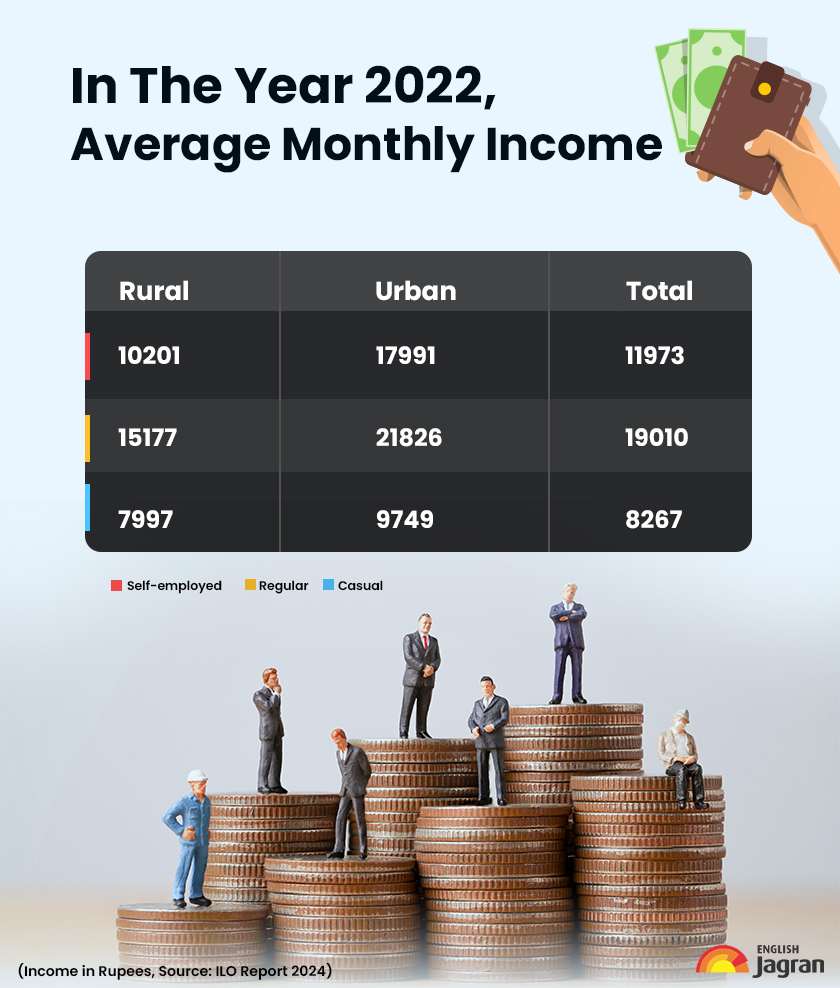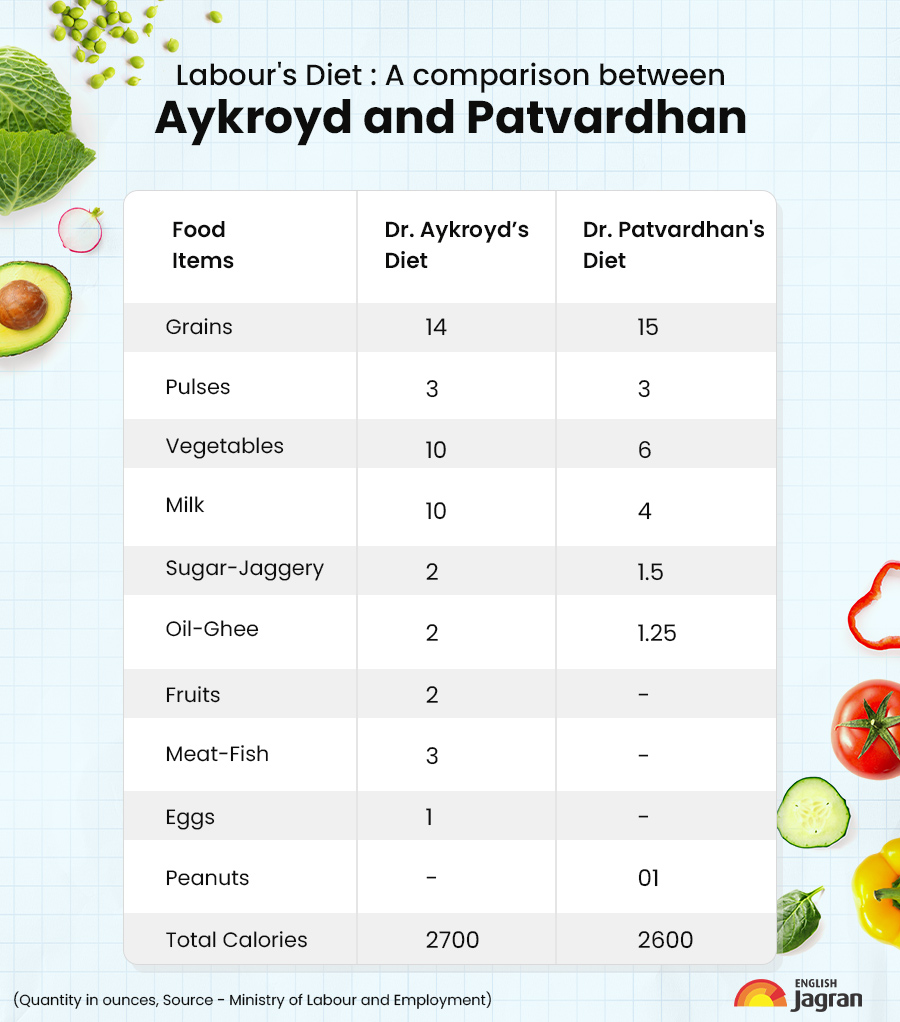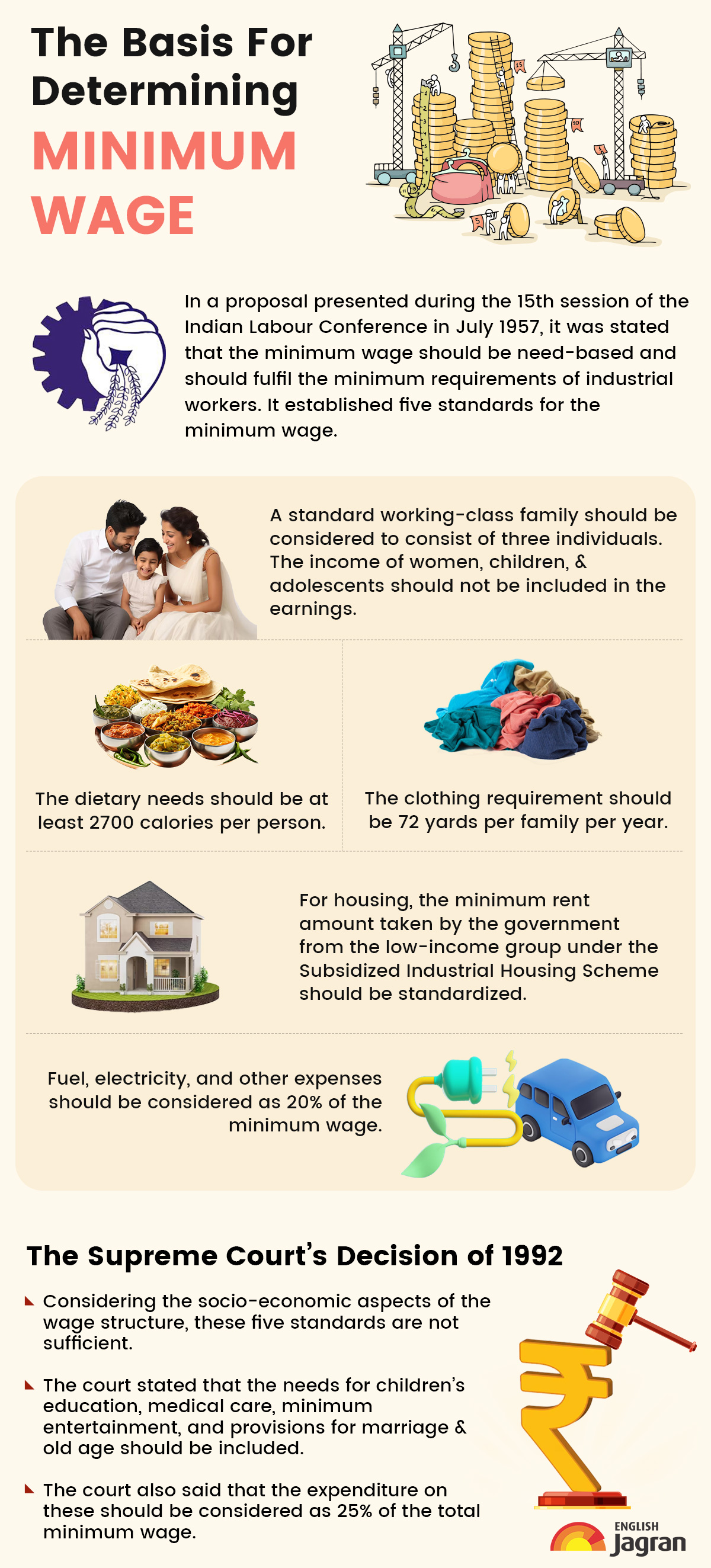- By Sunil Kumar Singh
- Tue, 09 Apr 2024 07:04 PM (IST)
- Source:JND
The recent news suggests that the government may replace the minimum wage with a living wage from next year. The International Labour Organization (ILO) will also be consulted on this matter. The law to determine the minimum wage in India was established in 1948 and the formula was created in 1957. Even today, the minimum wage is determined based on that six-decade-old formula. Experts say that in these six decades, the lifestyle of people, along with the entire world, has changed. Therefore, the formula for determining wages should be revised to align with today's needs.
The ILO released a report on the wage policy in February 2024. It states that a living wage is defined as the wage received during regular working hours (excluding overtime) that allows an employee and their family to live a dignified life. This was agreed upon during the 350th session of the ILO Governing Body held in Geneva from March 4 to March 14.
Minimum Wage Has More Than Doubled In Last 10 Years
In the year 1988, a proposal to link wages with the inflation rate of industrial workers was approved at the labour ministers' conference. Since then, the minimum wage includes a basic and variable dearness allowance (VDA). The allowance is linked to the Consumer Price Index. The VDA is revised every year on April 1 and October 1. The minimum wage varies according to cities. For this, cities are divided into three categories: A, B and C. Category A includes 17 cities such as Delhi, Mumbai, Kolkata, Bangalore, etc. Category B includes 87 cities. All cities outside the list come in the C region.
Workers are also divided into four categories to determine the minimum wage including VDA and basic pay - unskilled, semi-skilled, skilled and highly skilled. The central government sets the minimum wage for these categories in sectors like agriculture, mining, construction, warehouses, ports, cleaning, etc.
Over the past 10 years, the minimum wage has increased by about 2.3 times. According to the notification of the Chief Labour Commissioner (Central), as of April 1, 2024, the daily minimum wage for unskilled agricultural workers in A, B and C cities has been set at Rs. 497, Rs. 454 and Rs. 449 respectively. For highly skilled workers in these cities, the minimum wage is Rs. 652, Rs. 607 and Rs. 542 respectively. In construction, the minimum wage for unskilled workers in A, B and C cities is Rs. 778, Rs. 651 and Rs. 522 respectively. For highly skilled workers, it is Rs. 1028, Rs. 948 and Rs. 862 respectively.
Comparatively, on April 1, 2014, the minimum wage for unskilled agricultural workers in A, B and C category cities was Rs. 215, Rs. 195 and Rs. 193 respectively. For highly skilled workers, it was Rs. 283, Rs. 262 and Rs. 235 respectively. In construction, the minimum wage for unskilled workers in A, B and C cities was Rs. 329, Rs. 273 and Rs. 220 respectively. For highly skilled workers, it was Rs. 435, Rs. 400 and Rs. 363 respectively.

The Inception Of Minimum Wage In India
The concept of minimum wage in India was introduced in 1920 by economist K.G.R. Chaudhary. He proposed the formation of separate boards for determining the minimum wage in each industry. Based on the recommendations of the Standing Labour Committee and the Indian Labour Parliament, a Labour Investigation Committee was established in 1943 to consider labour along with housing, social circumstances and employment. The Minimum Wages Bill was introduced in the Central Legislative Assembly on April 11, 1946, but it was delayed in passing. Eventually, the Minimum Wages Act came into effect on March 15, 1948.
Chandan Kumar, the national coordinator of the Working People’s Charter, an organisation working for labourers, says, “The method of determining the minimum wage in the 1948 law was need-based. Its formula was decided for the first time in the 15th Indian Labour Conference in 1957.” The last meeting took place in July 2015.
In November 1948, the Central Advisory Council formed a tripartite committee in its first meeting, named the Committee on Fair Wages. It was tasked with creating a wage structure in the country. It included representatives from the government, private employers and employees. The committee defined three levels of wages - living wage, fair wage and minimum wage. According to the committee, there should be a fair wage between the living wage and the minimum wage.
Difference Between Living, Fair and Minimum Wage
The living wage is the highest level of salary. According to the Committee on Fair Wages, it includes an adequate amount for the basic necessities of food, clothing and shelter, along with education for children, good health, other social needs and sufficient funds for leisure time, based on the real income at 2012 values. However, the committee also stated that while determining the living wage, the national income and the industry's capacity to pay wages should also be considered. Therefore, the living wage should be the ultimate goal.
Dr. Santosh Mehrotra, Visiting Professor at the University of Bath, UK, says, “It is evident that the living wage will be higher than the minimum wage. But it is difficult to determine how much higher it will be. It would be better if the government comes up with a concrete plan.”
Chandan Kumar says, "The living wage is enshrined in the principles of fair wages. It can be said to be somewhat ambitious that as time changes, we will move towards the living wage from the minimum wage. But until the standards and processes for determining wages change, we cannot reach the real living wage."
Regarding the fair wage, the committee’s view was that the level of wages should maintain work efficiency along with production. Therefore, the wage board should assess the industry’s capacity to pay wages. There should be a separate board in every state and for each industry. Above all, there should be a central appellate board. According to the committee, the fair wage should be linked to the worker’s productivity and the prevailing wage rate. Based on these recommendations, the Fair Wages Bill was introduced in Parliament in August 1950, but it could not be passed.
The committee's view on minimum wages was that it should not only be for subsistence but also maintain the worker's work capacity. Therefore, education, healthcare and other essential services should also be included in determining the minimum wage.
An important part of the Minimum Wages Act is the Scheduled Employment List. The government determines the minimum wage for any sector it adds to this list. Chandan says, “In most states today, domestic workers are still not part of this list, so the government does not determine their minimum wage. This also means that these people are not categorised as workers. The same is true for the new-age gig workers.” If the minimum wage for a specific category of employees is to be determined, the first step is to include it in the Scheduled Employment List.
Why Is Minimum Wage Necessary?
The Minimum Wages Act Report 2019 states that the purpose of seeking employment is to earn a wage that allows a person to live a dignified life. It is the government’s duty to ensure every worker receives a fair wage to eliminate hunger and poverty, develop human resources and ensure social justice, without which law and order may be at risk. According to the Constitution, it is the responsibility of the state (country) to create an economic system where every citizen has employment and receives a ‘fair wage.’ The annual report of the Ministry of Labor and Employment for 2022-23 refers to the need for the Minimum Wages Act of 1948, stating, “No employer can pay less than this wage under any agreement. This law does not discriminate between men and women.”
Supreme Court’s Decision
In the case of Employee vs. Raptakos Brett & Co. in 1992, the Supreme Court validated the standards for determining the minimum wage. It also stated that considering the socio-economic aspects, these standards are not sufficient. The court suggested including additional components such as children’s education, medical needs, minimum entertainment and provisions for marriage and old age. The court also said that the expense on these should be considered as 25 per cent of the total minimum wage.
The Supreme Court has recognized the minimum wage as a legal right of workers. In the Crown Aluminium Works vs. Workers case in 1958, it was decided that if an industry cannot pay its employees the minimum wage, it does not have the right to continue operating. In People’s Union for Democratic Rights vs. Union Government (1982), it stated that paying less than the minimum wage is equivalent to forced labour. However, it is also true that the Supreme Court’s decision has not been fully implemented to date.
National Floor Level Minimum Wage
According to the Minimum Wages Act Report, there is no uniformity in the wage structures of different states. Some states determine a consolidated wage by combining basic and DA, while others keep DA as a separate component. To reduce the significant disparities in minimum wages across states and to create a uniform wage structure, the concept of National Floor Level Minimum Wage was introduced. It was established based on the recommendations of the National Commission on Rural Labour formed in 1991. The government implemented the National Floor Level Minimum Wage in 1996, setting it at Rs. 35 per day at that time. Before that, in October 1990, the minimum wage was set at Rs. 20. However, the National Floor Level Minimum Wage is not a statutory obligation.
Changes Necessary In The Method Of Determining Minimum Wage
The expert committee of the Ministry of Labour and Employment provided a report in January 2019 on the method of determining the national minimum wage. It stated, “Tripartite forums like the Indian Labour Conference, various committees and commissions have played a significant role in shaping the minimum wage policy. Much has been achieved from this. However, to attain dignified work and inclusive growth, it is essential to prioritise certain issues. These include low wages, wage inequality and gender discrimination.”
According to the report, to make India’s wage policy more effective, the government introduced the Wage Code Bill in Parliament in August 2017. The Wage Code has been prepared by combining the Payment of Wages Act 1936, Minimum Wages Act 1948, Payment of Bonus Act 1965 and Equal Remuneration Act 1976. It was notified on 8 August 2019, but its provisions have not yet been implemented.
In line with the provisions of the Wage Code Bill, the Ministry of Labour and Employment formed an expert committee on 17 January 2018. Dr. Anoop Satpathy of the V.V. Giri National Labour Institute in Noida was appointed as the chairman. The committee was tasked with creating a formula for determining the national minimum wage.
Key Recommendations Of The Satpathy Committee:
- An average of 3.6 members per family instead of three in every worker's family.
- Calculation of calories, protein and fat instead of only calories in the food basket.
- 2400 calories, 50 grams of protein and 30 grams of fat per adult daily.
- Expenses on essential items such as clothing, fuel, rent, education, healthcare, transportation, footwear and slippers.
- In July 2018, the national minimum wage was Rs. 375 per day, which is Rs. 9750 per month. An additional Rs. 55 per day (Rs. 1430 per month) as house rent allowance for urban workers.
- Adjusting the minimum wage every six months according to retail inflation. Develop a method to link future revisions to productivity.

Minimum Wage Based On Calories
The government’s food basket used in determining the minimum wage dates back to 1929. It was created by Dr. Wallace Ruddell Aykroyd. This basket only accounts for the expenses of three individuals. According to Dr. Aykroyd’s formula, the family units are as follows: the breadwinner counts as one unit, the wife as 0.8 units and two children as 1.2 units. It is assumed that the annual requirement of 72 yards of cloth per family does not include warm clothing. Therefore, this formula is not suitable for cold regions.
Chandan says, in countries like India, besides children, elderly parents also depend on the earning member in many families. Adding expenses for three people doesn't seem fair from anywhere. They say, "We are still determining wages based on the formulas of 1929 and 1957. During this time, the whole world has changed. Therefore, there is a need to change the formula for wage determination."
Dr. Wallace Aykroyd was initially a nutritionist who was appointed to the Health Department in Geneva by the League of Nations in 1931. In India, he was appointed as the director of the government's nutrition research centre in 1935. He was also the first director of the nutrition department in the Food and Agriculture Organization of the United Nations.
At the 15th Labour Parliament, the daily caloric requirement per adult was set at 2700 calories, in accordance with Dr. Aykroyd’s recommendation. Before 1957, the Textile Labour Enquiry Committee in 1940 and the United Provinces Labour Inquiry Committee in 1948 had attempted to determine a need-based minimum wage. The Bombay Textile Labour Enquiry Committee had considered 2600 calories per adult for food as the basis.

Challenges: Minimum Wage Fixed, But Not Fully Implemented
There have been many efforts in determining minimum wages, but according to experts, there is a lack of implementation in this regard. According to Mehrotra, "Minimum wage hasn't been implemented everywhere yet. At least in MGNREGA, the government should implement minimum wage." It is noteworthy that recently the government has increased MGNREGA rates by 8 to 10 per cent for the financial year 2024-25. The highest rate is in Haryana at 374 rupees.
Actually, wages depend on the quality of employment. This is evident from the recent 'India Employment Report 2024' by the International Labour Organization (ILO) and the Institute for Human Development (IHD). According to it, employment conditions improved from 2005 to 2022, but the trend slowed down thereafter. Especially after the COVID pandemic, the situation worsened. Despite minor improvements, employment conditions are not favourable.
According to the report, the share of employment in manufacturing is around 12 to 14 per cent. Most of the employment is in the informal sector and their quality is also not good. About 82 per cent of the workforce is in the informal sector and nearly 90 per cent of them are employed informally.
It is said that the wages of casual workers increased slightly from 2012 to 2022. The real wages of regular employees either remained stable or decreased. The actual income of self-employed individuals has also decreased after 2019. 62 per cent of unskilled casual workers in agriculture and 70 per cent of such workers in construction did not receive minimum wages in 2022. Employment in India increased by 1.6 per cent annually from 2000 to 2012, while during this period, gross value added increased at a rate of 6.2 per cent. From 2012 to 2019, the rate of increase in gross value added was 6.7 per cent, but during this time, employment growth was only 0.01 per cent annually.
According to the report, with the increase in mechanisation, the production process has become more capital-intensive. Between 2000 and 2019, there was a shift in employment and people moved from the less productive agricultural sector to the more productive non-agricultural sectors. People moved to the construction and service sectors. However, this change began to slow down by 2019.
From 2019 to 2022, employment grew annually by 3 per cent and GVA by 3.5 per cent. This can be associated with the recovery after the pandemic. Another important point is that most of the additional employment generated in manufacturing were regular and self-employed jobs. Their productivity and income were higher than in construction, agriculture and some services. According to the report, in 2022, 40.8 per cent of regular and 51.9 per cent of casual workers in agriculture did not receive the minimum wage. In the construction sector, 39.3 per cent of regular and 69.5 per cent of casual workers did not receive the minimum wage.
The ILO says that India’s labour market is largely unorganised and fragmented. Employment has increased in the organised sector, but many jobs in this sector are also of a casual nature. Chandan says, we need to change our perspective. Today’s gig workers, who work for large companies, have profits in billions of dollars, but their wages are not even Rs. 20,000. In addition, they are deprived of many facilities. It is essential to link wages to the company’s profit and production system. Only then will setting wages make sense, otherwise, the level of inequality will continue to rise.
(Note: This story has been translated by Ankit Kumar for Jagran English.)

